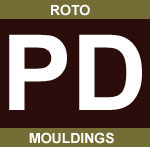



What is Rotomoulding?
Rotational moulding (or Rotomolding) is a process that is used to manufacture plastic products. It involves the heating and melting of a thermoplastic powder in a mould, the liquid polymer then coats the mould surface to produce the desired shape. This process is typically used to mould hollow parts, especially those with complex and varied shapes not easily obtainable by other hollow-art processes. It is a virtually shear-free and pressure-free process. The wall thickness uniformity and part weight can be easily maintained and there is very little waste of material due to scrap. The moulds used are normally less expensive than the moulds used in injection and blow moulding.
The Process |
|
1. Loading - This is where the polymer powder is loaded into the mould. |
Additives to help make the part weather resistant, flame retardant, or static free can be specified. Inserts, threads, handles, minor undercuts, flat surfaces that eliminate draft angles or fine surface detail can all be part of the design. Designers also have the option of multi-wall moulding that can be either hollow or foam filled.
|
Cost Advantages
Examples of Rotationally Moulded Products:
|